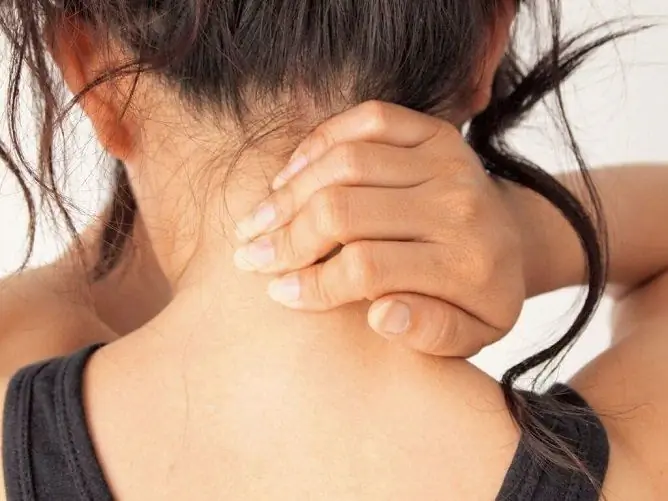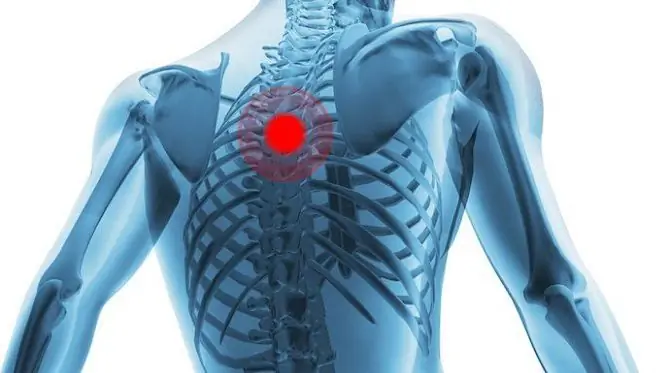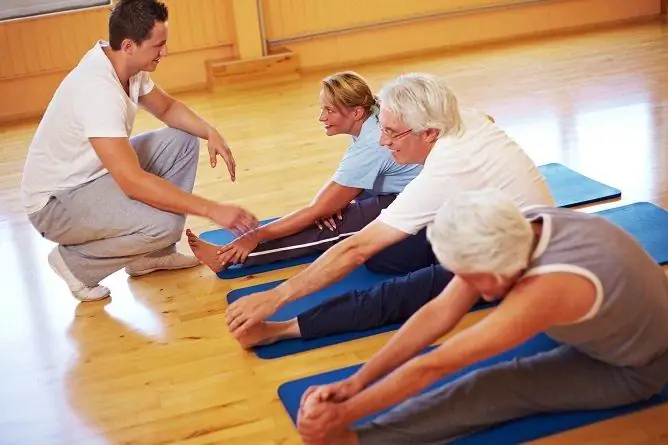- Author Rachel Wainwright [email protected].
- Public 2024-01-15 19:51.
- Last modified 2025-11-02 20:14.
Self-massage for osteochondrosis of the cervical spine
The content of the article:
-
Self-massage of the neck with osteochondrosis at home
- Relaxing massage
- Acupressure
- Recommendations for the procedure
- Contraindications
- General information about osteochondrosis of the cervical spine
- Video
Self-massage for osteochondrosis of the cervical spine can improve the patient's condition, relieve some of the symptoms of the disease and prevent the development of complications, but it should be done only after consultation with the attending physician and the first few times under his control.
The most effective procedure is at the initial stages of the disease.

Self-massage, performed regularly and with the correct technique, can be of great benefit for osteochondrosis
Attempts to self-medicate can lead to the development of complications (including compression of the nerve roots, increased blood pressure, the progression of the disease to the development of an intervertebral hernia).
Self-massage of the neck with osteochondrosis at home
There are a number of rules for performing massage at home. So, it is allowed to massage with one or both hands, the patient is recommended to sit during the procedure, sometimes you can massage while standing.
The following massage techniques are recommended:
- stroking the surface of the neck with an open palm;
- rubbing the affected area with fingertips;
- kneading with a shift of the skin;
- careful grips with pinches;
- light pat with fingertips.
The procedure consists of three main stages, which are presented in the table.
| Stage of the procedure | Description |
| Training | It consists in warming up tissues at the site of exposure, usually consists of rubbing the front and back of the neck to the back of the head, massaging the trapezius muscles, the clavicle region |
| The main part of the procedure | Use of physician-prescribed basic massage techniques |
| Completion | The session usually ends with light strokes |
It is not recommended to start the main stage without a preparatory one.
You can use several methods to carry out self-massage at home.
Relaxing massage
Gently stroking the back of the neck, shoulder and clavicle area. After this, stroking of the sides of the neck is performed, the patient tilts his head back and massages the front of the neck from the lower jaw to the chest and rubs the area behind the ears.
The following massage techniques can be used to affect the back of the neck:
- circular rubbing - performed with fingertips, the effect is made on the muscle frame, but not on the vertebrae;
- stroking - movements are performed from top to bottom (from the back of the head to the shoulder blades);
- squeezing - produced with the edge of the palm from the bottom up, after reaching the level of hair growth, change the direction (to the shoulder joint);
- pinches - performed from the bottom up and in the opposite direction, while the effect is carried out on deeper tissues.
To massage the front and side of the neck, you can use:
- stroking (from top to bottom, performed with the back of the hand, alternately changing hands);
- rubbing (circular movements in the chest area with your fingertips in a clockwise direction);
- kneading (perform light pinching from the earlobes to the shoulders).
The procedure helps to relieve tension and strengthen the neck muscles, fight spasms, pain, improve blood circulation and tissue metabolism, and eliminate puffiness. An evening session of a relaxing massage can normalize sleep, improve memory, and relieve headaches.
Acupressure
Classic massage can be supplemented with acupressure. The acupressure technique involves the impact on acupuncture points, which allows you to stop pain, eliminate spasm and relax the neck muscles, and improve blood circulation.
Recommendations for the procedure
- It is usually recommended to perform massage on your own at home 1-2 times a day (morning and evening).
- During the procedure, a person should not experience discomfort.
- You should not massage the vertebrae and lymph nodes.
For massage, you can use oils, honey, special massage creams.
Contraindications
It is not recommended to massage during an exacerbation of the disease, unless otherwise prescribed by the attending physician.
In addition, contraindications may include:
- the presence of benign or malignant neoplasms;
- severe diseases of internal organs;
- vascular pathology;
- skin diseases;
- violation of the integrity of the skin at the site of exposure;
- osteomyelitis;
- infectious and inflammatory processes in the body;
- increased body temperature or blood pressure.
General information about osteochondrosis of the cervical spine
Risk factors for the development of pathology include: an inactive lifestyle, frequent stressful situations, improper diet, poor posture, injuries, excessive physical activity, excess weight. In order for the treatment to be effective, they must be disposed of.
Patients may have the following symptoms:
- headache;
- dizziness;
- impairment of memory and attention;
- hearing and vision impairment;
- pain in the neck;
- numbness of the upper limbs;
- muscle weakness;
- pain in the region of the heart;
- blood pressure surges;
- nausea and vomiting;
- change in gait.
In addition to massage and self-massage, the patient can be prescribed drug therapy, physiotherapy methods of treatment, diet, exercise therapy. In severe cases, surgery is required.
For the prevention and elimination of symptoms with an already existing disease, it is recommended to sleep on an orthopedic mattress and pillows, give up bad habits, adjust weight, eat right, timely treat pathologies that can cause the development of osteochondrosis.
Video
We offer for viewing a video on the topic of the article.

Anna Aksenova Medical journalist About the author
Education: 2004-2007 "First Kiev Medical College" specialty "Laboratory Diagnostics".
Found a mistake in the text? Select it and press Ctrl + Enter.






